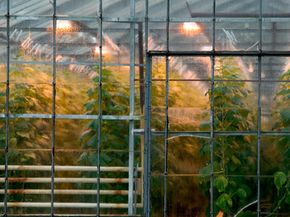Building a Greenhouse
If you want the biggest tomatoes in your neighborhood next season, need somewhere to over-winter your orchids or love the idea of having your own blooming flowers year round, a backyard greenhouse may be just right for you.
Building your own greenhouse used to be a difficult process requiring complicated building plans, expensive materials and professional assistance. Now, with the widespread availability of prefabricated kits, the process is easier and more affordable. The most popular greenhouse size is around 8 feet by 6 feet (2.4 meters by 1.8 meters), probably because it doesn't require a poured foundation. Whatever the size, placing the greenhouse so that it receives enough strong light and is in proportion to the rest of the property is an important consideration when considering a greenhouse addition.
Advertisement
When planning for a greenhouse, one of the first questions you should ask is about the types of plants you'll be keeping. The varieties of plants you choose will determine how warm the greenhouse will have to stay in winter, and to a degree, how large it will need to be. That coupled with the weather in your area will give you an idea of how much supplemental heat the greenhouse will need to maintain your plants at a safe minimum temperature.
Another concern is the amount of time you'll have available for maintenance. Automated ventilation, heating and watering systems can make keeping plants much easier, but at a cost. For automated systems to work, a power supply will be necessary, and any water delivery system needs access to a water line or water holding tank.
Some greenhouse styles are modular and can grow with you. That way you can start small and expand. Modular units are also well-suited to mixed applications. You can keep plants in different sections of the greenhouse separated by a divider.
If displaying your plants to advantage is one of your primary goals, a conservatory or sunroom may be the best choice. They're more expensive than bare-bones greenhouses but can be stunning additions to a property.
For lots more information on greenhouses, cultivating plants, getting your hands dirty and related topics, dig around the links below.
Related How Stuff Works Articles
More Great Links
Sources
- Bellows, Barbara, "Solar Greenhouse Resources." National Sustainable Agriculture Information Service. 2008. (9/12/2008). http://attra.ncat.org/attra-pub/solar-gh.html
- Bowling, Sue Ann. "How Do Greenhouses Work?" 4/20/1987, Accessed: 9/9/2008. http://www.gi.alaska.edu/ScienceForum/ASF8/817.html
- Britannica Online Encyclopedia, "Greenhouse," Undated, (9/12/2008). http://www.britannica.com/EBchecked/topic/245223/greenhouse
- Earth Observatory, Nasa, "Greenhouses of the Campo de Dalias, Almeria Province, Spain." Undated. (9/14/2008). http://earthobservatory.nasa.gov/Newsroom/NewImages/images.php3?img_id=16554
- Eden Project, "What's at Eden." Undated. 9/14/2008. http://www.edenproject.com/whats-at-eden/whats-here/index.php
- Grubinger, Vern. "Beneficial Insects For the Greenhouse." Vegetable and Berry Page University of Vermont Extension. Undated. (9/14/08) http://www.uvm.edu/vtvegandberry/factsheets/beneficialsGH.html
- Hessayon, D. G. "The Greenhouse Expert." New York: Sterling Publishing Co., Inc. (1994)
- Hobby Greenhouses. "The History of Greenhouses." Undated. (9/12/2008). http://www.hobby-greenhouse.com/history_of_greenhouses.htm
- In, Chris. "An Explanation of How Greenhouses Work." 1/21/08. (9/13/08). http://www.greenhousegardeningtips.co.uk/an-explanation-of-how-greenhouses-work/
- Italian Tourist Board. "Botanical Gardens in Italy." Undated. (9/11/2008) http://www.italiantourism.com/botanic.html
- Janick, Jules. "Agricultural Scientific Revolution: Mechanical." Purdue University, History of Horticulture. 2002. (9/14/2008). http://www.hort.purdue.edu/newcrop/history/lecture32/lec32.html
- Janick, Jules. "What the Roman Emperor Tiberius Grew in His Greenhouses." Undated. (9/12/2008). http://www.hort.purdue.edu/newcrop/2_13_Janick.pdf
- Martell, Arlene. "How Greenhouses Work - Greenhouse Gardening at Its Best." 8/25/08. (9/12/08) http://www.howitworks.net/how-a-greenhouse-works.html
- Mierswa, Dietric. "Step-By-Step Garden Guide, Greenhouse Gardening." UK: Grange Books (1994)
- Montenegro, Maywa. "Vertical Farms and Future Cities." 6/2/2008. (9/12/2008) http://gristmill.grist.org/story/2008/5/31/13335/3773
- Nasa - Science at Nasa, " Greenhouses for Mars." 2/25/2008. (9/14/2008) http://science.nasa.gov/headlines/y2004/25feb_greenhouses.htm
- North Carolina State University. "Greenhouse Food Production." 6/17/2008. (9/14/2008). http://www.ces.ncsu.edu/depts/hort/greenhouse_veg/
- Ross, David S. "Planning and Building a Greenhouse." West Virginia University Extension Service Fact Sheet. Undated. 9/12/2008. http://www.wvu.edu/~agexten/hortcult/greenhou/building.htm
- Royal Botanic Gardens, Kew. "Temperate House." Undated. (9/13/2008). http://www.kew.org/places/kew/temperatehouse.html
- Sorenson, Dan. "Greenhouses for the Moon and Mars." 1/7/2007. (9/12/2008) http://www.azstarnet.com/sn/science/163564
- Tremlett, Giles. "Spain's Greenhouse Effect: The Shimmering Sea of Polythene Consuming the Land." Guardian,co.uk. 9/21/05. (9/15/08) http://www.guardian.co.uk/world/2005/sep/21/spain.gilestremlett
- World Heritage Foundation. "Kew Gardens, London." Undated. (9/14/2008). http://www.great-britain.co.uk/world-heritage/kew-gardens.htm
